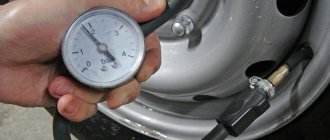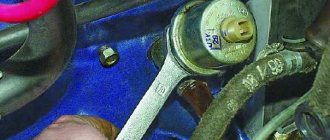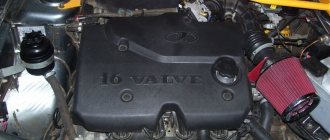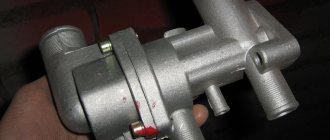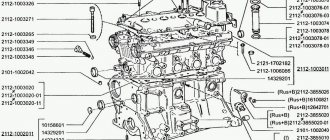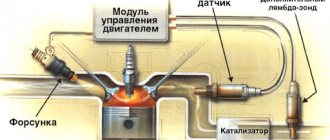Questions regarding what is the optimal pressure value in the engine are asked by a large number of car enthusiasts, regardless of the make of the car. After all, such discussions arise only because the standard instruments installed on the instrument panel do not represent dial or graphic indicators, but only a warning lamp. It signals extreme pressure, when the car may no longer be safe to use. Thus, monitoring the state of oil pressure in real time is simply unrealistic.
In the video, the low oil pressure warning light on a VAZ 2110-2112 came on.
Why do you need oil?
Is oil the lifeblood of the engine? This is not entirely true, of course, the comparison is very rough, but still, the engine will not function without oil (or it will, but not for a very long time). Modern motor oils lubricate and protect all rubbing parts, and these are pistons (with their rings), shafts, bearings, etc. Let's just say that good oil extends the life of the engine by many thousands of kilometers.
BUT oil must flow through the system, just like blood itself through human vessels, if the oil is simply poured in a pan and does not go to the rubbing parts - IT IS USELESS!
Functions, structure and location of the VAZ 2110–12 oil pump
The engine lubrication system is designed to timely supply engine oil to the moving and hottest elements of the power unit. Oil is supplied from the sump and circulates through special channels inside the block and cylinder head. The oil pump ensures forced circulation of the lubricant.
Location of the oil pump on the VAZ 2110–12
On the VAZ 2110–12, the oil pump is located in the lower right corner of the cylinder block under the crankshaft gear, which drives the gas distribution mechanism.
The oil pump is located in the lower right corner of the engine under the crankshaft gear
This applies to both eight and sixteen valve engines. The pump housing is also the side cover of the power unit.
Oil pump device
The design of the oil pump is very simple and includes the following elements:
- housing with lid;
- driving and driven gears;
- pressure reducing valve with spring;
- oil receiver
The oil pump has a simple design based on two gears
Operating principle of the oil pump
The pump is driven by the crankshaft through the drive gear. The latter rotates the driven gear, creating a reduced pressure at the input of the device and increased pressure at the output. Thus, oil from the crankcase flows through the oil receiver tube into the pump, and from it into the engine oil line. When the pressure inside the pump begins to exceed the permissible value, a spring-loaded pressure relief valve drains excess oil back into the sump.
What builds up oil pressure in the system?
Everything is simple here - there is a special oil pump that takes oil from the engine sump and pumps it through the system.
It is usually installed in the engine sump and driven by special gears that the engine turns during operation. Oil begins to flow through many channels to the right places under pressure - this is the crankshaft and its bearings, the camshaft and its “bed”, pistons, and much more. It is the pump that is responsible for the pressure; if the pump stops, the pressure indicator will drop to zero. THIS CANNOT BE ALLOWED! Because the engine will not be lubricated at all, which will lead to instant breakdown, especially at high speeds.
BUT often the oil pump does not stop, but simply begins to pump worse, this indicates its wear, which is why you need to know the oil pressure in the engine! To respond in time to the nearest oil pump failure.
conclusions
When measuring a 16-valve VAZ 2112 engine, the pressure gauge shows the following indicators: idle speed - 1.8 bar; speed 4-5 thousand - 5 bar. This is quite enough for the systems to function normally and for no interruptions in engine operation.
Car shock absorber oil
Proper operation of shock absorbers is the key to a comfortable and safer ride. If there is a lack of oil in this suspension part, the braking distance becomes longer and repairs are required more often. Which oil to choose for shock absorbers?
Korean engine oils: which is better to choose
Let's start with the fact that over the past two decades, South Korea has been included in the list of recognized leaders both in the automotive industry and in the production of fuels and lubricants. Today, original Korean motor oils
Japanese engine oils - review and selection tips
Japanese engine oils have proven themselves well in the domestic market. Lubricants made in Japan have sufficient viscosity to ensure normal operation of engines at low temperatures.
Selection of oil by car brand: index and oil composition
Motor oil is an integral companion of any car engine, regardless of the brand of the manufacturer of a particular vehicle. As is known, during use this drug loses
Choosing the right quality Shell engine oil for your car
Popular engine lubricant Modern production technologies ensure high quality Shell oils. The main advantage of the company’s motor lubricant is the presence of active detergents
Selection of Motul oil by car make online
or select a category Using the Motul online service for selecting motor oils and other automotive fluids, you can easily and quickly make the right, as well as high-quality
Comma oil
Comma Oil & Chemicals Ltd was founded in the UK in 1965. Currently, it is the largest world-class manufacturer in the field of automobile oils, auto chemicals and auto cosmetics.
Selection of oil by car make
Properly selected lubricants extend the service life of the most important machine components, improve their performance characteristics, and also reduce the cost of repair and maintenance of the vehicle.
Selection of Castrol oil by car make. Important tips!
Castrol oil owes its birth to the British company CC Wakefield Co, which currently occupies a leading position in the market. Once upon a time, the creation of the world's first motor oil additive (1909) was extraordinary.
Selection of Shell oil by car and vehicle make
What does every car enthusiast who chooses oil for his car want to get? The quality of the selected product, which can provide reliable protection of the machine from breakdowns, saving money, both
Emergency oil indication
Of course, now in almost all cars there is an emergency indication for a complete lack of pressure, this is known to us all - a “burning oil can”. If it does not go out for some time after starting, for example 10 - 20 seconds is one thing, it is almost always the fault of the oil filter. But if the lamp is constantly on, then this is already an alarm bell. Perhaps the oil pressure sensor has simply failed, or perhaps the oil pump has failed. In any case, the alarm indication is very important!
Remember this rule, if the lamp comes on, then turn off the car and preferably immediately to a service station, either a tow truck, or in tow.
What value should it be?
To begin with, it is worth noting that pressure is measured in bars (BAR), because we are measuring liquid. It’s unlikely that anyone will tell you the exact values now, because the structures of the engines are different, but there is a certain normal interval.
AT idle speed it is 2 BAR (or 0.2 MPa), for most cars
At 4000 - 5000 rpm - this is 4.5 - 6.5 BAR (0.45 - 0.65 MPa), also for most brands
If we take our VAZ 2112 16 valve version, then the pressure at idle is slightly higher, about 1.5 - 2.5 BAR. But at 4000 - 5000 rpm 0.4 - 0.6 BAR.
Actually, I’ll end here, I think the information was useful, read our AUTOBLOG.
(4 votes, average: 2.75 out of 5)
Similar news
Why do you close the radiator in winter? Let's say with cardboard, the necessary knowledge
Mileage 100,000-150,000 km. Is it a lot or a little, what needs to be changed? Ra.
OTTO cycle. ATKINSON. MILLER. What is it, what are the differences in ra.
Comments
Good day everyone, I decided to write my review of the 2010 Toyota Avensis. Just want…
TOP articles for the month
I have many different articles and videos on various gearboxes, for example here...
I already have an article on the website about choosing memory cards (you can see it here), it’s very...
In the article - is it possible to open windows when the air conditioner is running (you can read it here), I was asked...
How to check oil pressure?
The actual check is carried out using a special device - a pressure gauge. It is also worth noting that you need to warm up the engine to operating temperature, usually 90 degrees Celsius. If you measure with a cold engine, especially in winter, the pressure can jump to high values, from 0.5 BAR or even higher, but measuring with a cold engine is WRONG!
In order to check the pressure, you need to find the emergency sensor, which is responsible for the indication on the dashboard. It is worth noting that it is not always located nearby and it is convenient to unscrew it. We unscrew it, and in its place we attach the test output connected to the pressure gauge.
The check can then be divided into two options:
- AT “idle” it is usually from 900 to 1200 rpm.
- Then at “higher” speeds, usually 4000 - 5000 engine speeds.
It is also worth noting that if you unscrew the emergency sensor, the “oil can” will light up on your instrument panel, this is normal. Now a short video showing how measurements are taken.
Oil pressure in the VAZ 2112 16kl engine - logbook Lada 2110 GRAVICAPA 2001 on DRIVE2
I drove myself and didn’t know any grief, but a couple of days ago, I was driving in the evening, and as happens with Lada cars, when you let off the gas, the revolutions dropped to 500-700 and leveled off, but at the moment of the fall, I noticed that the emergency pressure lamp was blinking, maybe it was earlier It blinked like that, but I didn’t see it because I don’t drive much in the evening. Well, since I am a meticulous person regarding the condition of the car, I went looking. First of all, I measured the pressure on a cold and hot engine
When cold, my slightly decreasing (0.2-0.3) pressure gauge showed 2.5, when warmed up to 90 degrees it showed 0.3.
Thoughts were about the oil pump, liners, the ring on the oil receiver, the distributor bed and the distributors themselves. I started with the ring on the oil pump and the liners, removed the pan, then the oil receiver, everything turned out to be clean and without pieces of sealant, I unscrewed all the liners in turn, both the liners and the elbow did not raise any doubts, I only changed the ring on the receiver
I fill in new oil, and now we have 0.5-0.6 when hot. Well, it’s unlikely that the problem is in the ring, but rather in the new MANOL 1040 oil. I called naxi, he tried to dissuade me from buying a new oil pump, and recommended removing the valve cover and blowing into the hole of the emergency pressure sensor. I take off the cover, blow, and see oil splashing from under all the shaft journals. Well, now the thoughts are that the last person who assembled the cylinder head put everything on Kazan sealant, a crooked bed, etc... we take everything apart to get to the shafts and see this! The photo was taken immediately after removing the bed and removing the hydraulic seals, there is no sealant anywhere!
Now we wash everything we took out, and grind what we didn’t remove.
I washed and cleaned the bed, and went over it with 800-grit sandpaper to remove scratches and bring the bed at least a little closer to the shafts. We measure the shaft journals and see
If you look in the books, the new shafts are 23.9. Then I realized that it was better to change the shafts, naxi called again And here they lie
The shafts from the store drove 9 thousand, their measurement showed 23.87.
We apply LACTIDE, not Kazan and other sealants,
and screw up the bed
The tightening torque is 2 kg, but since everything was done with a small ratchet of 8, the torque wrench cannot be used (so we pull everything in a circle a little bit in about 3 passes, and with the last pass we tighten it without fanaticism. And then new seals, plugs and spark plug rings wells,
My rings were sealed, but I installed new ones without sealant. After assembly, the pressure on the hot one became
but some kind of hydraulic clunking in cylinders 2 or 3, the clattering is not strong but slightly noticeable, but noticeable damn it (well, I think I’ll drive for a while, maybe it will go away.
I think I’ve solved the pressure problem, the main thing is that the hydraulic fluid calms down now)
Oil filter
A clogged and worn oil filter invariably leads to a decrease in oil pressure in the system. In a serviceable, correctly selected and installed filter, a certain amount of lubricant always remains after the engine is stopped. This is provided for by the design of the device. If the filter is worn out, or does not correspond to the engine modification, oil will flow from it into the crankcase, causing a “starvation” effect in the engine.
When the filter element becomes clogged, its throughput capacity decreases. In this case, the pump operates in normal mode, however, the amount of oil entering the system is reduced. Naturally, this leads to a drop in pressure. If you are unsure whether the installed filter matches the engine parameters, or the car with it has traveled more than 7 thousand km, replace it. A new filter unit for a VAZ 2110 will cost you about 200 rubles.
Important: it is advisable to replace the filter simultaneously with changing the lubricant. When installing a new filter, be sure to fill the housing with fresh oil. This will prevent the appearance of air locks in the system and protect the engine from oil starvation.
When replacing the oil filter, be sure to fill the filter housing with fresh oil.
What value should it be?
To begin with, it is worth noting that pressure is measured in bars (BAR), because we are measuring liquid. It’s unlikely that anyone will tell you the exact values now, because the structures of the engines are different, but there is a certain normal interval.
AT idle speed it is 2 BAR (or 0.2 MPa), for most cars
At 4000 - 5000 rpm - this is 4.5 - 6.5 BAR (0.45 - 0.65 MPa), also for most brands
If we take our VAZ 2112 16 valve version, then the pressure at idle is slightly higher, about 1.5 - 2.5 BAR. But at 4000 - 5000 rpm 0.4 - 0.6 BAR.
Actually, I’ll end here, I think the information was useful, read our AUTOBLOG.
Similar news
- Why do you close the radiator in winter? Let's say with cardboard, the necessary knowledge
- Mileage 100,000-150,000 km. Is it a lot or a little, what needs to be changed? Ra...
- OTTO cycle. ATKINSON. MILLER. What is it, what are the differences in...
Check and replacement
During operation of the VAZ-2112, various malfunctions may occur. For example, the oil pressure sensor may fail. However, before drawing conclusions about the causes or presence of a possible breakdown, you should first check the functionality of the device.
The check is performed as follows:
- First of all, check the circuit connecting the DDM and the control lamp. To do this, take the sensor wire and lean it against the surface of the engine. At the same time as this action, you should see if the light on the dashboard is on. If the lamp goes out, then the wiring is fine and the problem is really in the sensor.
- The next step is to remove the device from the vehicle for a visual inspection. The first sign of a breakdown is the presence of moisture on the sensor.
If the DDM turns out to be dry and everything is in order with the wiring, it is recommended to look for the problem elsewhere. For example, the malfunction may be in the oil level or its quality. You can also replace the oil filter if necessary.
There is another way to check the functionality of the sensor in the VAZ-2112. It is considered more reliable and proven. In this case, you will need to use a pressure gauge, and the sequence of actions will look like this:
- First of all, it is necessary to warm up the engine until it reaches operating temperature, and then turn it off.
- Next, you need to unscrew the sensor from the car and screw in the pressure gauge in its place.
- The ground wire of the pressure gauge will need to be connected to the ground of the vehicle.
- After this, you need to connect the control LED to the battery.
- The next action is to turn on the engine and press the gas pedal. In this case, it is necessary to take into account that the speed rises gradually.
When the action is completed, you should carefully monitor the pressure gauge and LED. If the device readings reach 1.2 and 1.6 bar, but the LED does not go out, then the sensor is faulty and needs to be replaced.
To carry out the replacement you will need:
- Stock up on the necessary tools, as well as a new sensor.
- Disconnect the wires from the old device.
Unscrew the sensor using a wrench.
Remove the unit
In this case, during the dismantling process, you should pay attention to the fact that the sealing ring should come out along with the sensor. It will also need to be replaced
- Install a new sensor.
- Check the contacts and clean them if necessary, then connect the wires.
When all the steps are completed, you can start the engine again and check the serviceability of the sensor.
